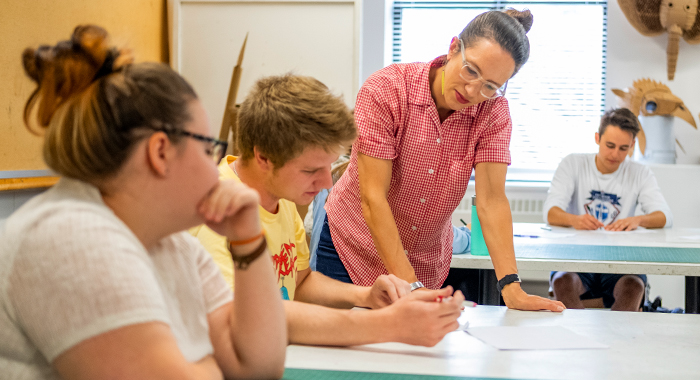Design Students Get Down to Business
The Student Design Center, part of a new course launched this semester by Katie Ries and Brian Pirman (Art), welcomes graphic design commissions from all over campus. The center, with its 10 student designers, is open to a wide range of campus community-geared projects, including Instagram and Snapchat images, social media campaigns, merchandise, pamphlets, banners and logos.
The group takes on design projects, learning along the way how commercial design studios work in practice. The students are not all design majors, but all have design skills, having taken the prerequisite Intro to Design and Computer Graphics.
Learning from constructive criticism
The center procures project briefs from around campus and students are given the freedom to create a design. Then the group collaboratively critiques each option, and everyone gets a chance to revise before the client chooses an option, Ries explains. “Everyone gets to make work for their portfolio, but the work that the client likes best will be the work that solves the problem.
“If your work is consistently not chosen you will still learn something. The thicker your skin can be, the better. A lot has to do with knowing what you’re saying and who you’re talking to, who the audience is and who it’s going to serve. We get the best results in graphic design when we are clear about all those things.”
As well as meeting design needs on campus, mainly from faculty, the center aims to “provide opportunities for fieldwork and professional experience for our students. They have to hear the client’s brief, understand their needs and provide a solution.”
Ries adds that the Student Design Center also taps into liberal arts ideals by meeting both academic and community needs plus giving the designers a sense of their power as professionals. “One of the texts we’ll be reading is ‘Design Ethics’ by Mike Monteiro, a firebrand designer, which begins: ‘A designer is first and foremost a human being.’”
The business of design
Payment is not only a motivating factor but core to the course’s purpose. Ries says, “We want to train people on the campus to be good clients and pay appropriately for the skill that students have spent time cultivating. Students should not be being paid in exposure or working to add to their portfolio.
“Our students and their parents are concerned about jobs, which is understandable, but it doesn’t always occur to students that they have a say in what work they do and who they serve, which is an important lesson. In fact, our design students get jobs because they have soft skills alongside technical skills: they are good with clients.”
Meet some of the first Student Design Center team
Gia Minneci
Graphic design major
As the graphic design intern for SNC’s office of communications, Gia Minneci ’24 already has some of the real-world experience that Student Design Center offers. Minnecci says, “That’s a much faster turnaround, but you’re not building something from zero; it’s more likely that you will be working with an existing brand or concept.
“With Student Design Center we are making new work for a particular purpose. My other classes teach about how to make things and how to think critically about design, but not about how a design studio works as a business.
“While a liberal arts education is giving you everything you need to be a well-rounded person, being part of the Student Design Center is giving you a well-rounded experience of design. It makes you think critically about customer interaction, communication, copy: all things which maybe you might not encounter in specific arts programs. I like the critique element: I know I didn’t do it perfectly the first time, so I want to know how to improve.”
Cate Nelson
Fine art and environmental science major
Cate Nelson ’24 is dedicated to improving her graphic design skills both to market her own artwork and to support her work at the Norman Miller Center for Peace, Justice & Public Understanding. “As environmental scientists we can use design skills to do advocacy work and spread our message,” she says.
“I’m learning so much by being with a group of peers, all working independently on the same projects, being inspired by each other and critiquing one another, seeing what works and what doesn’t. Critiquing is so important for growth and for spotting patterns in your work so you can be more intentional.
“We’re putting design into the context of different places where design is important, where it can speak and where it has value. It’s an opportunity for collaboration across the curriculum.”
Sydney Suchy
Graphic design and Spanish major
Sydney Suchy ’24 says, “Having to communicate the exact message that clients want for something that will be used immediately is a different kind of expectation than completing an assignment. We have a quick turnover, and you have to be organized and stay on top of the task.
“Right now, we have two projects going on at once, a book for the Art & Democracy course and a poster. We’re working as a team but also individually. We’re bouncing ideas off each other and hearing one another’s perspectives on our work; people with more experience will notice small details you are not alert to.
“In my other courses, I’ve now learned the value of taking a step back before I submit and trying to see the work from other perspectives myself.”
Oct. 27, 2022












